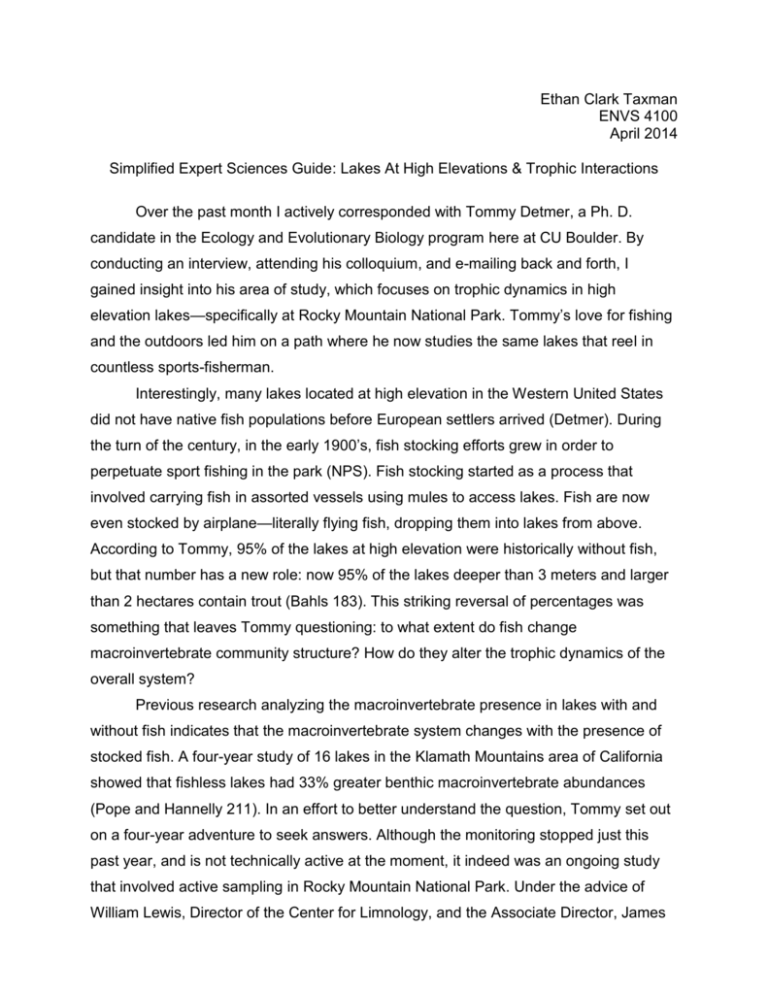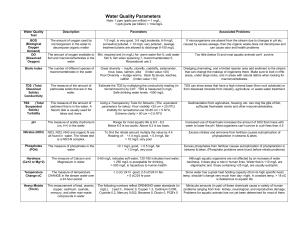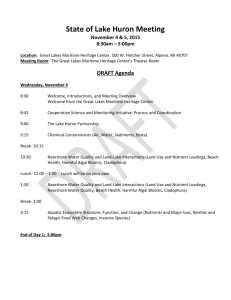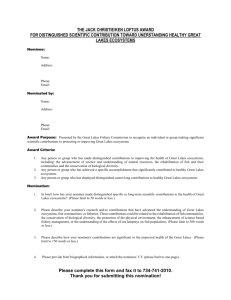Ethan Clark Taxman ENVS 4100 April 2014 Simplified Expert
advertisement

Ethan Clark Taxman ENVS 4100 April 2014 Simplified Expert Sciences Guide: Lakes At High Elevations & Trophic Interactions Over the past month I actively corresponded with Tommy Detmer, a Ph. D. candidate in the Ecology and Evolutionary Biology program here at CU Boulder. By conducting an interview, attending his colloquium, and e-mailing back and forth, I gained insight into his area of study, which focuses on trophic dynamics in high elevation lakes—specifically at Rocky Mountain National Park. Tommy’s love for fishing and the outdoors led him on a path where he now studies the same lakes that reel in countless sports-fisherman. Interestingly, many lakes located at high elevation in the Western United States did not have native fish populations before European settlers arrived (Detmer). During the turn of the century, in the early 1900’s, fish stocking efforts grew in order to perpetuate sport fishing in the park (NPS). Fish stocking started as a process that involved carrying fish in assorted vessels using mules to access lakes. Fish are now even stocked by airplane—literally flying fish, dropping them into lakes from above. According to Tommy, 95% of the lakes at high elevation were historically without fish, but that number has a new role: now 95% of the lakes deeper than 3 meters and larger than 2 hectares contain trout (Bahls 183). This striking reversal of percentages was something that leaves Tommy questioning: to what extent do fish change macroinvertebrate community structure? How do they alter the trophic dynamics of the overall system? Previous research analyzing the macroinvertebrate presence in lakes with and without fish indicates that the macroinvertebrate system changes with the presence of stocked fish. A four-year study of 16 lakes in the Klamath Mountains area of California showed that fishless lakes had 33% greater benthic macroinvertebrate abundances (Pope and Hannelly 211). In an effort to better understand the question, Tommy set out on a four-year adventure to seek answers. Although the monitoring stopped just this past year, and is not technically active at the moment, it indeed was an ongoing study that involved active sampling in Rocky Mountain National Park. Under the advice of William Lewis, Director of the Center for Limnology, and the Associate Director, James McCutchan, Tommy’s study was underway. As mentioned, Tommy began in 2009 and the duration of his experiment was a four-year period that ended in 2013. By utilizing willing undergraduates, they sampled three to four times per year between the four years during both good and bad weather conditions and times of day. To properly conduct the study, both lakes with fish and lakes without fish were monitored. Some physical and chemical parameters were gathered, but the main focus of the study was the macroinvertebrate collection. To sample for benthic macroinvertebrates in these lakes, the students and Tommy used bottom sediment cores, as well as a benthic sled, which is basically a kick net that is dragged along the bottom by rowing the boat. In addition to the benthic macroinvertebrate sampling, Tommy also conducted hook and line surveys in the lakes to verify the presence of trout, as well as verifying with historical stocking records. During and after the course of the sampling period, extensive analysis was conducted to determine the significance of their study. Repeated measures ANOVA analysis demonstrates that lakes without fish averaged almost double the benthic macroinvertebrate biomass than lakes with fish (832 mg m-2 in fishless lakes compared to 448 mg m-2 in stocked lakes—see graph 2). Tommy notes that lakes with fish have fewer large taxa, which is a direct result of predation by fish. His finding is similar to a comparison of three kinds of lakes in Yosemite National Park that were originally fishless, had stocked fish remaining or were reverted back to fishless. That study indicated that stocked-fish lakes had 16% fewer taxa than lakes that had never been stocked (Knapp, Hawkins, Ladau, and McClory 843). In addition, the study of the never stocked fishless lakes in the Klamath Mountains revealed about 40% higher taxon richness (Pope and Hannelly 201). The fish are tempted by larger macroinvertebrates, and suppression occurs. Years ago, when the National Park Service decided to stock non-native fish in lakes that were previously untouched by fish, they may not have known the extent of their actions. After all, stocking fish is seemingly harmless, especially when the goal is to promote an industry that has been and remains extremely popular in Colorado. It is interesting to think that the most “wild” lakes in the United States are actually totally manipulated, because they are derived of populations of fish that were introduced by humans, not by natural occurrence. In 1970, stocking efforts by the park were reconsidered, and according to the National Park Service, in 1975 only native Greenback cutthroat and the Colorado River cutthroat Trout were being stocked (NPS). Graph 1 demonstrates the number of fish stocked over time. It is clear where the initial policies on stocking and revised policies occur. Non-native fish are not being stocked and active removal is underway. It is definitely a good thing that they reconsidered their policy on fish stocking. Some of the reasoning behind this was to protect the natural system, which was home only to the two previous trout species mentioned above, and they were not in 95% of moderately sized lakes at high elevations historically. That being said, as part of an effort to please multiple stakeholders, they were able to demonstrate that they indeed cared for the integrity of the environment by removing non-native trout species, and continuously stocking native trout species. By doing so, they made fisherman happy, as well as nature enthusiasts who are unhappy with nonnative species. But, this does not address the issue of the macroinvertebrates. The Park Service is obligated to protect native species, but even though two species of trout may be native to this region, the thing is, they were not native to the lakes at high elevation, because the geographic relief creates obstructions that prevent spawning, according to Tommy. It puts the Park Service in a hard position, and they have tried their best to manage the situation, but in my opinion, this is a decision that had unforeseen consequences at the time of its highest popularity and we are realizing this later—a common theme in environmental issues. Trophic interactions in a system are important to monitor because they can be directly correlated with ecosystem dynamics. Tommy mentioned in the conclusion of his EBIO Colloquium that suppression of larger taxa of macroinvertebrates in these lakes disrupts the bird communities. If the fish are selecting larger prey, this leaves less food for the birds that rely on aquatic macroinvertebrates as part of their diet. During my interview with him, he mentioned that there are many more birds around fishless lakes than lakes with fish. He said he even saw an otter in a fishless lake, which is an extremely rare sighting. Research supports Tommy’s observations. For example, a study of the Gray-crowned Rosy-Finches (Leucosticte tephrocotis dawsoni) in the Sierra Nevada Mountains in California showed that there were 98% fewer mayflies in troutstocked lakes than in the fishless lakes, which directly affected the food supply for these birds (Epanchin, Knapp and Lawler 2411). The trout were able to consume the majority of the mayfly nymphs as they emerged, leaving very few mayfly adults for the Rosy- Finches to forage. The study determined that in that area, mayfly production was reduced by 70% due to the introduction of trout, causing an 83% average decrease in the number of Rosy-Finches feeding at lakes where trout had been introduced compared to fishless lakes (Epanchin, Knapp and Lawler 2411). Notably, this research indicated there were 5.9 times more Rosy-Finches at fishless lakes than at troutstocked lakes (Epanchin, Knapp and Lawler 2406). To me, even though Tommy’s study involves monitoring underwater, where we may not easily see the direct impacts non-native fish bring to the pristine system, this study has merit. His research showed that the presence of fish do have an impact on the trophic dynamics of the ecosystem. As well, interactions between consumers, primary producers and water quality are important considerations. Tommy’s findings demonstrate that human actions have consequences, and it is important to review all possible outcomes before undergoing such actions. 2000000 1800000 1600000 1400000 1200000 1000000 800000 600000 400000 200000 0 1886 1891 1896 1902 1907 1912 1917 1922 1927 1932 1937 1942 1947 1952 1957 1962 1967 1972 1977 1982 1987 1992 1997 2002 2007 2012 Number of fish stocked in Rocky Mountain National Park Graph 1: Year Graph depicting the stocking activity—demonstrates the policy of reduction of fish stocking in the 1970s, also demonstrates the boom at the turn of the century. Data from Fish and Wildlife Service. Graph 2: Biomass (mg m-2) Benthic invertebrate biomass per unit area 1000 900 800 700 600 500 400 300 200 100 0 Lakes without fish Lakes with fish Graph depicting biomass of macroinvertebrates in lakes with and without fish. Analysis found using repeated measures ANOVA (p<0.001%) by Tommy Detmer. Works Cited: Bahls, Peter. “The status of fish populations and management of high mountain lakes in the western United States.” Northwest Science 66.3(1992) 183-193. Web. 30 April 2014. Detmer, Thomas. “Lakes at high elevation: A model system for explaining variation in cascading trophic interactions.” University of Colorado Boulder. 4 April 2014. Ecology and Evolutionary Biology Department Colloquia Graduate Seminar. Detmer, Thomas. “Presentation abstract and speaker biography for ‘One fish too…many fish? Understanding the changes caused by fish introductions in lakes at high elevations’.” Boulder County Nature Association. 16 March 2013. Song of the Alpine: Climate Change and the Resilience of High Elevation Ecosystems 20th Annual Boulder County Ecosymposium. Web. 5 April 2014. Detmer, Thomas. Personal interview. 2 April 2014. Epanchin, Peter, Roland Knapp, and Sharon Lawler . “Nonnative trout impact an alpinenesting bird by altering aquatic-insect subsidies.” Ecology 91.8(2010): 2406–2415. Web. 26 April 2014. "Fishing." Rocky Mountain National Park. United States National Park Service, n.d. Web. 5 April 2014. Knapp, Roland., Charles Hawkins, Joshua Ladau, and Jodi McClory. “Fauna of Yosemite National Park Lakes has low resistance but high resilience to fish introductions.” Ecological Applications 15.3 (2005):835-847. Web. 26 April 2014. Pope, Karen and Erin Hannelly. “Response of benthic macroinvertebrates to whole-lake non-native fish treatments in mid-elevation lakes of the Trinity Alps, California.” Hydrobiologia 714(2013):201–215 Web. 26 April 2014.









